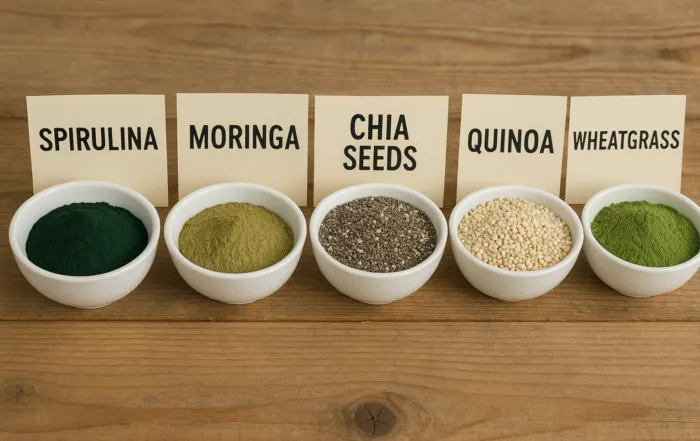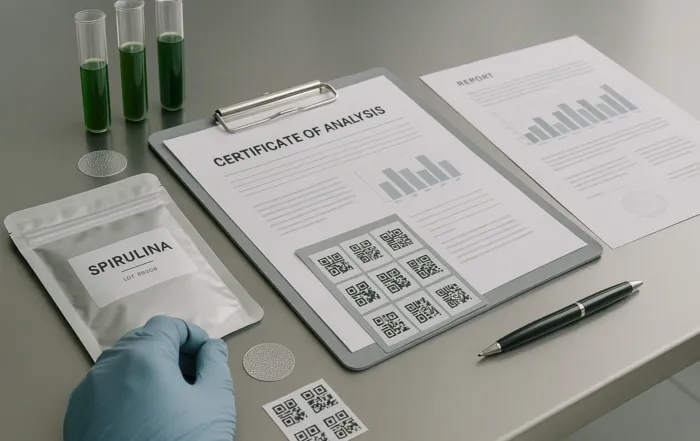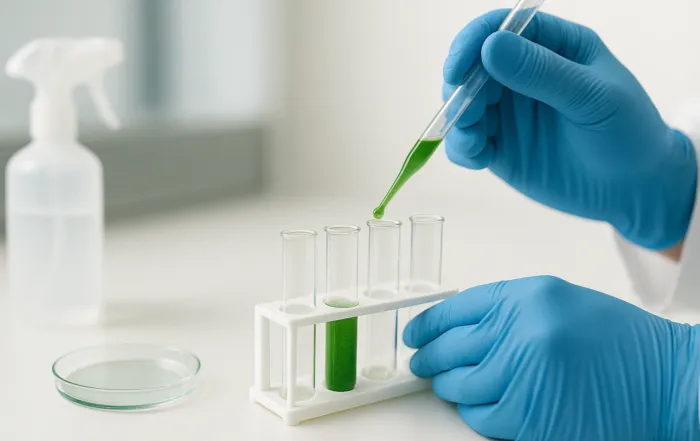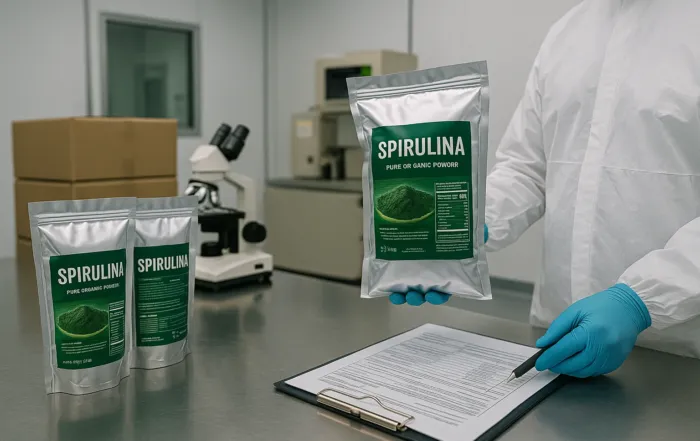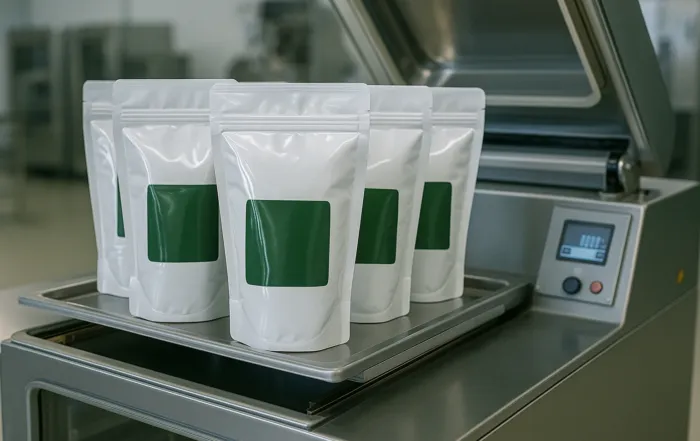The Lab Setup You Need for Export-Grade Spirulina
SEO Title: The Lab Setup You Need for Export-Grade Spirulina
Meta Description: Discover the essential lab setup for export-grade spirulina. Learn required equipment, testing protocols, and certifications for global compliance.
Introduction
Export-grade spirulina is not just about cultivation-it is about proving its safety, purity, and nutritional value to international buyers. Whether targeting the U.S., EU, or Asian health supplement markets, spirulina producers must provide a Certificate of Analysis (COA) backed by robust laboratory testing. Without an in-house lab setup, achieving USDA Organic, HACCP, and GMP certification becomes nearly impossible.
This blog explores why labs are critical, what equipment is needed, the required tests, and how investments in lab infrastructure open the doors to global markets.
Why Labs are Critical for Export-Grade Spirulina
Spirulina destined for human consumption must meet the highest safety standards. Export buyers demand:
- HACCP compliance: Proof that hazards are identified, monitored, and controlled.
- GMP certification: Evidence of clean, contamination-free production.
- USDA/EU Organic certification: Documentation that inputs are chemical-free and the product is tested for residues.
Without a dedicated lab, farmers cannot generate credible batch-wise reports. As a result, consignments often face rejection at customs or fetch lower local prices instead of premium export rates. To secure access to nutraceutical, cosmetic, and food-grade markets, an export-ready lab is non-negotiable.
Core Functions of a Spirulina Lab
A properly designed spirulina lab supports multiple functions:
1. Analytical Testing
- Protein percentage (must be >60%).
- Pigments like phycocyanin and chlorophyll-a.
- Fatty acid profile (GLA, omega-3, omega-6).
- Moisture and ash content.
2. Microbiological Testing
- Total microbial count.
- Yeast and mold counts.
- Absence of pathogens such as E. coli, Salmonella, and Staphylococcus aureus.
- Coliform testing to ensure safety.
3. Heavy Metal & Toxin Testing
- Lead, arsenic, cadmium, and mercury must be below permissible limits.
- Pesticides and herbicides must be absent.
- Screening for PAH, PCB, and aflatoxins to meet international safety norms.
4. Batch Traceability
Every spirulina batch must have complete records, including:
- Harvest date and pond conditions.
- Lab test results.
- Packaging and lot numbers.
- Final COA before dispatch.
This traceability ensures buyers and certifying agencies can track products back to their source.
Essential Lab Equipment
Setting up an export-grade spirulina lab requires specialized equipment for both analytical and microbiological testing. Below is a breakdown of essential instruments and their applications.
| Equipment | Application | Approx. Cost (INR) |
| pH Meter (0–14 range) | Culture monitoring | ₹10,000 |
| TDS/Conductivity Meter | Nutrient and salt monitoring | ₹15,000 |
| Refractometer | Salinity measurement | ₹10,000 |
| UV Spectrophotometer (Shimadzu UV-1800) | Pigment & protein analysis | ₹1,50,000 |
| Cooling Centrifuge (10,000 RPM) | Sample analysis | ₹1,50,000 |
| Microscope (Olympus) | Sample and contaminant analysis | ₹50,000 |
| Laminar Air Flow Chamber | Sterile inoculation | ₹75,000 |
| Muffle Furnace (1100°C) | Ash analysis | ₹40,000 |
| Autoclave | Sterilization of glassware | ₹80,000 |
| Hot Air Oven | Moisture testing & sterilization | ₹26,000 |
| BOD Incubator | Microbial growth chamber | ₹80,000 |
| Digital Weighing Machine | Accurate chemical measurements | ₹50,000 |
| Spectrophotometer & Kjeldahl Apparatus | Nutritional profile testing | ₹40,000–₹60,000 |
Total estimated lab cost: ₹20–30 lakhs for a fully functional export-grade setup.
Additional Export-Grade Testing
Export markets often demand more than basic COA. Additional required tests include:
- Pesticide residue analysis – ensures no contamination from nearby agriculture.
- Aflatoxin detection – critical for compliance with U.S. FDA standards.
- PCB & PAH tests – to confirm absence of industrial pollutants.
- Shelf-life stability tests – to guarantee product longevity in global shipping.
Without these reports, shipments risk rejection even if basic tests are passed.
HACCP & GMP Requirements
A spirulina lab must align with international food safety and pharmaceutical standards:
- Separate Labs: Analytical and microbiological labs must be housed separately to prevent cross-contamination.
- SOPs (Standard Operating Procedures): Detailed documentation for every lab test and cultivation step.
- Trained Staff: Skilled microbiologists and lab technicians are mandatory for credibility.
- Cleanroom Integration: Packaging and storage must occur in controlled environments, only after lab clearance.
For detailed setup guidelines, refer to How to Build a HACCP-Compliant Spirulina Facility.
Investment Costs for Lab Setup
The cost of establishing an export-grade spirulina lab depends on scale:
- Small-scale farms: Can outsource some tests to third-party labs but still need basic pH, TDS, and microbial equipment. Investment: ₹5–10 lakhs.
- Mid-scale commercial farms: Require full in-house testing with UV spectrophotometer, centrifuge, and microbial facilities. Investment: ₹20–30 lakhs.
- Large-scale farms targeting exports: Need GMP-compliant labs with advanced testing (PAH, PCB, pesticide residue). Investment: ₹40–60 lakhs.
Although the costs are high, ROI is significant. Certified spirulina fetches premium prices in global nutraceutical and food supplement markets. Learn more in Economic Viability of Large-Scale Spirulina Production.
Long-Term Sustainability Advantage
A lab is not just about compliance-it ensures sustainability and consumer trust:
- Detects contaminants early, preventing product recalls.
- Ensures every batch is export-ready, reducing rejection risk.
- Supports organic and eco-friendly branding.
- Builds credibility with international buyers.
For broader insights into building resilient farming operations, see Spirulina Farming as a Sustainable Business.
FAQs
1. What is a COA and why is it needed for spirulina exports?
A Certificate of Analysis (COA) is a lab report verifying spirulina’s nutritional profile, safety (no heavy metals or contaminants), and compliance with international standards. It is mandatory for exports.
2. What lab equipment is mandatory for spirulina certification?
At minimum, farms need pH meters, UV spectrophotometers, centrifuges, microbial incubators, and laminar airflow chambers. Full export-grade labs require advanced toxin and residue testing systems.
3. Can small farms export without in-house labs?
Small farms can outsource testing but still face challenges with traceability and batch-wise certification. In-house labs build buyer confidence and streamline certification audits.
4. How much does a spirulina testing lab cost?
A mid-scale lab setup costs ₹20–30 lakhs, while large-scale export-oriented labs can cost ₹40–60 lakhs, depending on testing capabilities.
Conclusion
For spirulina farmers aiming at the global market, a lab setup is not optional-it is the foundation of success. From testing proteins and pigments to ensuring the absence of heavy metals and pathogens, labs guarantee compliance with USDA Organic, HACCP, and GMP standards. While investments may seem steep, the returns in terms of export readiness, premium pricing, and buyer trust are unparalleled.
By building a robust lab infrastructure, spirulina producers can transform from small-scale cultivators to international suppliers of superfood-grade spirulina.


